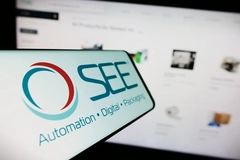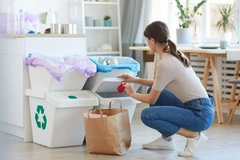The future of brand engagement? SharpEnd founder explores connective pack potential amid new Clinique partnership
26 Sep 2022 --- London-based IoT agency SharpEnd is bolstering Clinique’s latest Moisture Surge 100H “More Than You Think” campaign with its Near Field Communication (NFC) technology. The American personal care and cosmetics company has rolled out jars equipped with unique digital identities across 35 markets worldwide, including with UK retailer Boots, to enhance its brand-consumer engagement.
In this exclusive interview with PackagingInsights, Cameron Worth, CEO and founder at SharpEnd, discusses the rise of NFC technology in the beauty sector and consumers’ willingness to engage with connective packaging. We also explore the importance of data protection and how data accumulation can benefit businesses.
How widespread is NFC within the beauty and packaging industries?
Worth: In 2006, when the first NFC-compatible mobile phone, Nokia 6131, was released, we didn’t know quite how much NFC technology would revolutionize packaging in the years to come. Today, NFC technology is increasingly being used by brands across many different industries to make their packaging “connected,” delivering a digital experience for consumers from a physical product – from connected wine bottles to clothing and beauty products.
Although still an emerging trend in the beauty industry, we are seeing an increasing number of beauty brands embrace connected packaging to offer their consumers an experience-led gateway to exclusive content. From skin analysis to product recommendations, how-to tutorials, and loyalty rewards – brand experiences are creating a meaningful connection with consumers post-purchase. A simple tap of the NFC-enabled physical packaging is driving consumer engagement in the brand’s digital realm.
What is the significance of the Clinique project for NFC’s growth?
Worth: By rolling out NFC-enabled connected moisturizers across 35 markets in Spring 2022, Clinique created a beauty industry first, inspiring more beauty brands to experiment with connected packaging. Emilia Clarke fronted the campaign, which was the first time many consumers around the world would have been introduced to the concept of connected packaging and what it can give them.
 SharpEnd found 53% of consumers said they would pay more for connected products.Another example is the popular beauty brand, Too Faced, which last month released over 100,000 samples of connected lip glosses in partnership with BoxyCharm – the monthly subscription box service. BoxyCharm subscribers can tap the NFC tag on lipgloss to access bespoke content and receive a discount on their next purchase.
SharpEnd found 53% of consumers said they would pay more for connected products.Another example is the popular beauty brand, Too Faced, which last month released over 100,000 samples of connected lip glosses in partnership with BoxyCharm – the monthly subscription box service. BoxyCharm subscribers can tap the NFC tag on lipgloss to access bespoke content and receive a discount on their next purchase.
What barriers are left to be overcome before NFC is used more widely?
Worth: With beauty brands beginning to adopt NFC more widely, there is still a job to do to educate consumers on its use. A recent SharpEnd report, the Connected Experience Report (2021), revealed that awareness and understanding of NFC are not fully clear to consumers, even though many are actually using it regularly to make contactless payments in their daily lives. Only 28% of consumers have engaged with connected packaging via NFC.
The report also revealed an overall favorable response to connected products – 53% of consumers said that they are ready to pay more for connected products. With all smartphones equipped with in-built NFC readers, and more brands launching NFC-enabled connected packaging campaigns, we will continue to see awareness and engagement with NFC products quickly rise in the coming years.
For brands adopting NFC, an “experience-first” approach is key to consumer engagement. Many brands understand that consumers don’t want to be simply bombarded with offers and meaningless ploys to engage with them online where they don’t get anything of real value back in return. There’s an opportunity here for brands to be storytellers, provide value and foster a meaningful connection with consumers.
How likely are consumers to engage with connective packaging?
Worth: While there’s still some consumer education needed around the use of NFC, the big positive for brands is that 52% of consumers who are aware of NFC like using it. And this will grow as more brands adopt it. In SharpEnd’s report, the first-ever definitive study on how and why consumers engage with connected products, a clear rising affinity with NFC-enabled connected products was detected amongst consumers:
- 65% of consumers said they would willingly take the time to work out how to engage with a product via their smartphone.
- 86% of consumers who like NFC agree that the technology is exciting.
- 55% of consumers are more likely to buy a connected product if it introduces them to a new product experience.
If a brand factors in that they need to include an education element to their product launch plans, then any fears of consumer adoption can be cast aside – the high engagement received by the Clinique demonstrates this.
How important is data protection, given that NFC can detect where and when a product is being used and how people emotionally engage with mobile content?
Worth: Data protection is rightly a top priority for brands and technology businesses such as SharpEnd as consumers demand ownership of their personal data. Data generated from connected experiences is first-party data by default, meaning no third-party apps or social media can ever access it or use it to serve ads. Worth believes that connected packaging can be one of the most powerful marketing channels for beauty brands.
Worth believes that connected packaging can be one of the most powerful marketing channels for beauty brands.
Connected packaging develops a two-way relationship between the brand and its consumers. Consumers choose to share their data on their own terms in exchange for the connected experience. However, connected campaigns should run on trusted identity management platforms to ensure data privacy compliance. For example, SharpEnd’s identity management platform, io.tt, has analyzed billions of touchpoints to provide vital consumer insights for brands. Used in more than 100 countries, it is an invaluable tool to tie data to individual consumer profiles, so it becomes clear who buys a product, and where or how it is used. The platform has obtained several security clearances and adheres to a strict data protection protocol.
What can companies like Clinique do with the collected data?
Worth: The data gathered via connected packaging presents a golden opportunity for beauty brands to understand how, when and where their consumers engage with their products. The more they know about each consumer, the easier it is to provide truly personalized brand experiences – making the consumer feel supported and closer than ever to the brand. Connected packaging can also be leveraged by beauty brands to launch loyalty programs and reward repeat purchases. Some 66% of consumers would interact with connected packaging if it was linked to a loyalty program, according to The Connected Experience Report.
By Natalie Schwertheim












